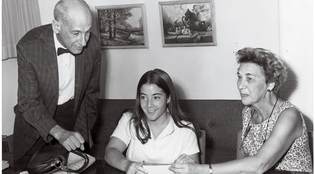 loading
loading
features“On the advisability and feasibility of women at Yale”The coeducation debate at Yale College  Manuscripts & ArchivesAmy Solomon ’73 (center) was the first woman to register as a student in Yale College. View full image“Yale may admit women,” read a headline in the New York Times. “Nothing Stands in the Way But Lack of Funds.” That was in 1891. A Miss Irene W. Coit had passed the Yale College entrance exam. It was a purely academic exercise, but President Timothy Dwight was nevertheless interested in opening a “woman's annex.” There was no question, the Times stressed, of men and women taking classes together. In fact, men and women had been taking classes together at Yale since 1869, the year the art school opened. (See Old Yale.) The graduate school began admitting women in 1892. By the late 1960s, nearly 1,000 women enrolled at Yale every year. But in 1891, “Yale” to the Times (and most of the campus) meant Yale College. And almost 80 years would elapse between Miss Coit's successful exam and the admission of the first female undergraduates at Yale. Yale started thinking seriously about college coeducation in 1966, when Yale and Vassar decided to explore “coordinate coeducation.” The idea was for Vassar, which was then a women's college, to sell its campus and relocate its students to Prospect Hill. Vassar would become Yale's Radcliffe. This plan for a simple add-on -- a twentieth-century “woman's annex” -- had decided political attractions. President Kingman Brewster ’41, according to his then-assistant, Henry Chauncey Jr. ’57, lived in “fear and trembling” about how college alumni would react to coeducation if their sons couldn't get into Yale. Yale College was more than an exclusively male school; it was a school that cultivated and cherished a particular ideal of maleness. “The word 'Yale' has taken on a meaning of its own in which the element of masculinity is clearly dominant,” wrote an alumnus of ’26 in a 1969 letter to this magazine. “The turtleneck sweater, the curved pipe, the bulldog shoes may bring a laugh, but underneath it all lies a pride that every Yale man understands.” But as the alumni resisted, the students pushed. Chauncey remembers that Lanny Davis ’67, ’70LLB, a pro-coeducation Daily News editor (and later White House counsel in the Clinton administration), “beat the drums day in and day out and, in a wonderfully positive way, harassed the hell out of us.” Davis was just one of many. Undergraduates held rallies, wrote imperious opinion pieces for the News, even organized “Coeducation Week” as a kind of pilot project. Brewster himself had unwittingly set up this conflict between the alumni and the alumni-to-be, by starting to admit college applicants based more on academic performance than on Yale family connections and where they had prepped. (For the definitive account, see “The Birth of a New Institution.”) Yale was admitting ever-larger numbers of public school students, and most of them had never experienced sex-segregated schooling, let alone thought of it as a matter of honor. Then, in November 1967, Vassar's board turned down the merger. The move left Yale with no plan and little time. All the other Ivies except Dartmouth were by now either coeducational or preparing to become so, putting Yale at a disadvantage in the competition for academically outstanding college applicants. “Yale realized,” says Elga Wasserman ’76JD, the assistant dean whom Brewster eventually appointed to oversee the planning committee on coeducation, that “they were going to lose some of the brightest young men if they remained all-male.” On November 9, 1968, the Corporation, Yale's board of trustees, approved Brewster's plan to admit 250 female freshmen and 250 female transfer students to Yale College the following September. Coeducation Week had only just ended -- but, the Yale Alumni Magazine assured its readers, that was a coincidence: behind the Corporation's decision “was a considerable period of discussion on the advisability and feasibility of women at Yale.” There were rocky patches in the first few years. The lopsided gender ratio left some women feeling isolated, some overwhelmed by excessive male attention. Facilities were overcrowded. Brewster tried to appease furious alumni with the promise that Yale College would continue to produce “a thousand male leaders” every year. But in the end, coeducation succeeded, settled in, and became the norm. In the pages that follow, we excerpt passages from publications of the time and recent interviews with participants in the transformation. — The Editors
|
|